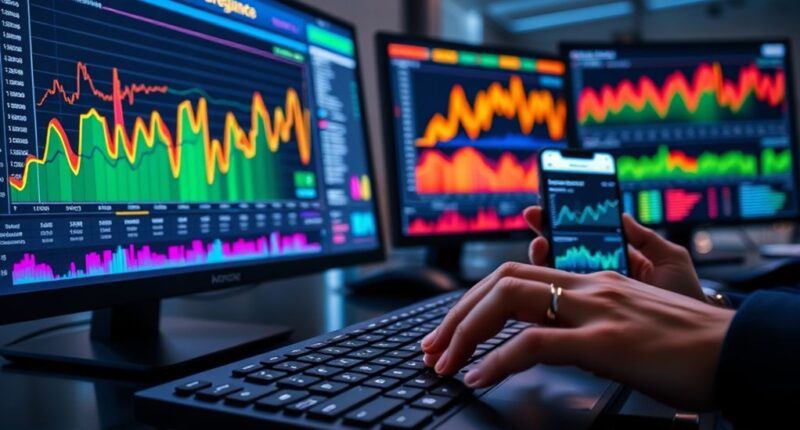When your music streams online, platforms collect revenue from subscriptions and ads, then distribute royalties to rights holders. These payments include digital-performance royalties, which go to artists, songwriters, and publishers for public performances and reproductions. Streaming services track each play, and rights organizations guarantee fair payout based on how often your music is streamed and their contracts. To learn more about how your work gets compensated, keep exploring this process in detail.
Key Takeaways
- Streaming platforms generate revenue from subscriptions and ads, which is pooled for royalty distribution.
- Rights organizations track and report song plays to ensure accurate royalty calculations.
- Royalties are divided among rights holders based on stream counts, platform market share, and licensing agreements.
- Mechanical licenses cover reproduction rights, while public performance rights handle royalties for streaming as public playback.
- Proper licensing and reporting ensure fair compensation for artists, songwriters, and rights holders from digital streams.

Digital-performance royalties are payments artists and rights holders receive when their music is streamed or played on digital platforms like Spotify, Apple Music, and online radio. These royalties are essential for ensuring creators are compensated for their work in the digital age. When your music gets played on these platforms, the streaming services generate revenue, which is then distributed to rights holders through a complex process involving various licenses. Understanding how these royalties are calculated and paid involves grasping concepts like mechanical licenses and public performance rights.
Mechanical licenses are crucial because they grant permission to reproduce and distribute copyrighted music. In the context of digital streaming, these licenses cover the reproduction of your music in a digital format, ensuring that streaming services have legal authorization to host and distribute your tracks. When you sign with a publisher or a licensing organization, they typically handle obtaining mechanical licenses on your behalf. This process ensures that every time your song is streamed, the necessary rights are accounted for, and you receive your fair share of the revenue generated from reproducing your work digitally.
Mechanical licenses authorize reproduction and distribution of digital music, ensuring legal rights and fair compensation for streamed works.
Public performance rights come into play because streaming platforms are considered public venues where your music is played to a broad audience. When your song is streamed, it’s akin to a live performance in a public space, so rights organizations like ASCAP, BMI, or SESAC collect royalties for these public performances. These organizations monitor the usage of your music across different platforms and distribute the royalties accordingly. The public performance aspect is vital because it recognizes that your music is being enjoyed publicly, even if it’s through a digital medium rather than a traditional concert.
The process of paying out digital-performance royalties involves multiple steps. First, streaming services track how often each song is played and report this data to rights organizations. Then, the collected revenue from subscriptions and advertising is pooled and divided based on the number of streams, the market share of each platform, and other contractual factors. Rights organizations then allocate these funds to copyright owners, including songwriters, publishers, and performers, through the appropriate licenses. Mechanical licenses ensure the reproduction rights are covered, while public performance rights ensure that you’re compensated for your music’s public broadcast.
Frequently Asked Questions
How Are Digital-Performance Royalties Calculated for Different Streaming Platforms?
You’re paid digital-performance royalties based on how streaming platforms use royalty calculation and streaming algorithms. These platforms analyze your streams’ share of total plays, factoring in user subscriptions and ad revenue, then distribute royalties proportionally. Different platforms may have varying algorithms that influence payouts, but generally, your earnings depend on your share of total streams, the platform’s payout rate, and the royalty calculation method they employ.
Who Qualifies to Receive Digital-Performance Royalties?
If you own the rights or are a performer, you’re eligible for digital-performance royalties. While streaming platforms pay listeners, your streaming rights determine if you qualify. You must have a legal stake, like publishing rights or recording ownership, to collect royalties. This eligibility guarantees creators and rights holders benefit from streams, making it essential to understand your streaming rights and establish proper agreements to secure your rightful earnings.
How Do Artists Track Their Streaming Royalty Earnings?
You can track your streaming royalty earnings through royalty tracking tools provided by your distributor or aggregator. Use streaming analytics dashboards to monitor your plays, revenue, and geographic data in real-time. These platforms often offer detailed reports, making it easier for you to comprehend your income sources and identify trends. Regularly checking these analytics ensures you stay informed about your streaming performance and earnings.
What Is the Difference Between Digital-Performance Royalties and Mechanical Royalties?
You should know that digital-performance royalties come from performance rights and are paid when your music is streamed or played publicly, mainly through performance rights organizations. Mechanical royalties, on the other hand, are generated from the reproduction of your music, like downloads or physical copies. In royalty distribution, performance royalties cover live and streaming plays, while mechanical royalties are for sales and reproductions, ensuring you get paid for each type of usage.
How Do Digital-Performance Royalties Impact Artists’ Overall Income?
Digital-performance royalties considerably boost your overall income by ensuring you get paid for streaming and public performances through music licensing. These royalties are part of the royalty distribution process, meaning your earnings grow as more streams occur. They provide a steady revenue stream, especially for popular tracks, and help diversify your income sources beyond album sales, giving you a more sustainable financial foundation in the music industry.
Conclusion
Understanding digital-performance royalties is like steering a complex river—you need to know the currents to stay afloat. Streaming payments may seem straightforward, but they’re part of a larger ecosystem that directly supports artists and creators. By staying informed, you help guarantee the flow of fair compensation continues. Remember, every stream is a drop in the ocean of music’s future—your awareness can help steer that tide toward fairness for everyone involved.









